Abstract
A within-subject design was used to characterize the effects of dose manipulations on discriminative and self-reported effects of oral diazepam and buspirone. Subjects were trained to discriminate diazepam (10 mg) versus placebo (n = 10), or buspirone (10 or 15 mg) versus placebo (n = 9). The compounds were identified to subjects by letter code before discrimination training began. In later sessions, correct identifications at 2 hr after the oral administration of drug earned money. All subjects showed accurate discrimination performance during the test-of-acquisition phase. In a low-dose generalization phase, diazepam and buspirone produced dose-related increases in drug identifications across a four-fold range of doses. In a subsequent low-dose training phase, in which subjects were trained to discriminate progressively lower drug doses, the median lowest discriminable dose of diazepam and buspirone was 2.5 and 7.5 mg, respectively. Dose-response functions for drug identifications were shifted leftward in the low-dose training phase relative to the low-dose generalization phase, suggesting that reinforcement of progressively lower doses enhances drug discriminability. The self-reported effects of diazepam and buspirone were similar (e.g., both drugs increased ratings of drug strength and clumsy/uncoordinated) and different (e.g., diazepam but not buspirone increased ratings of drowsy/sleepy; buspirone but not diazepam increased ratings of tense/nervous). This study demonstrates discriminative and self-reported effects of diazepam and buspirone at doses lower than previously shown to be behaviorally active, and suggests that at commonly used clinical doses, diazepam is relatively more discriminable than buspirone.
Full text
PDF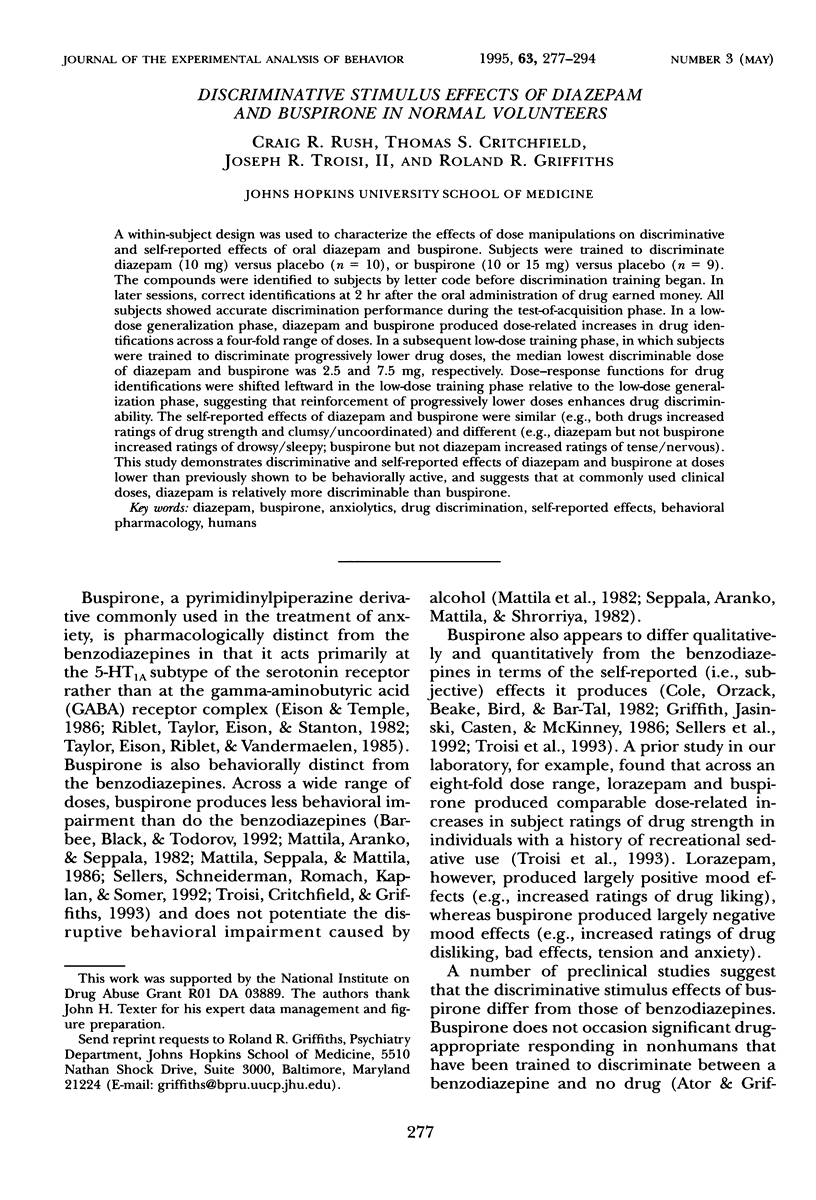
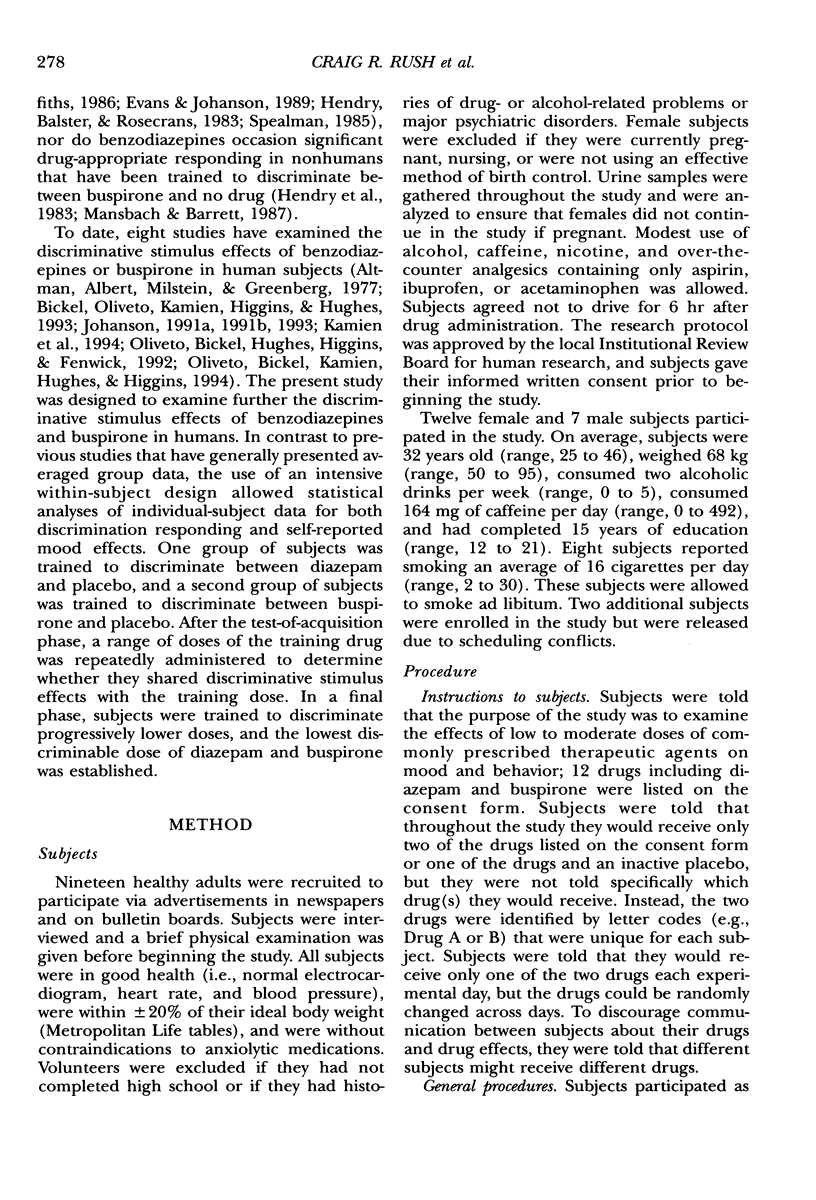
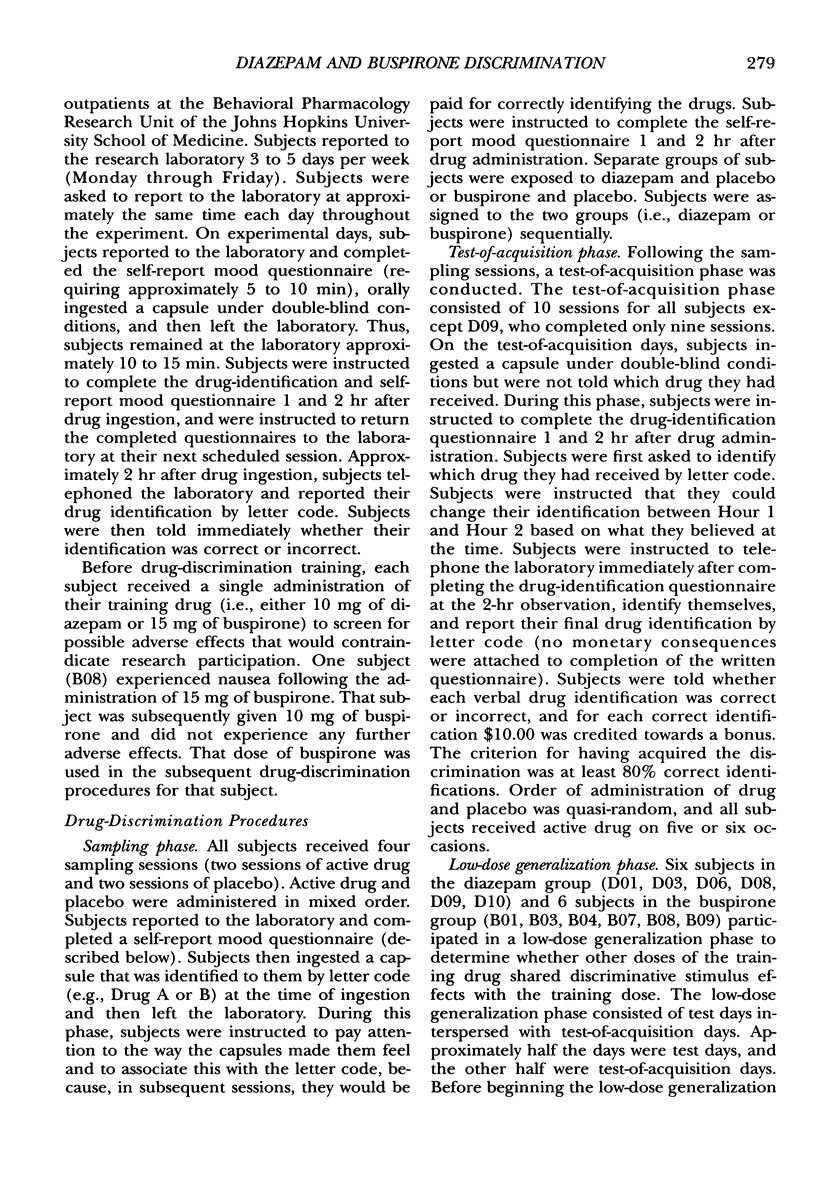
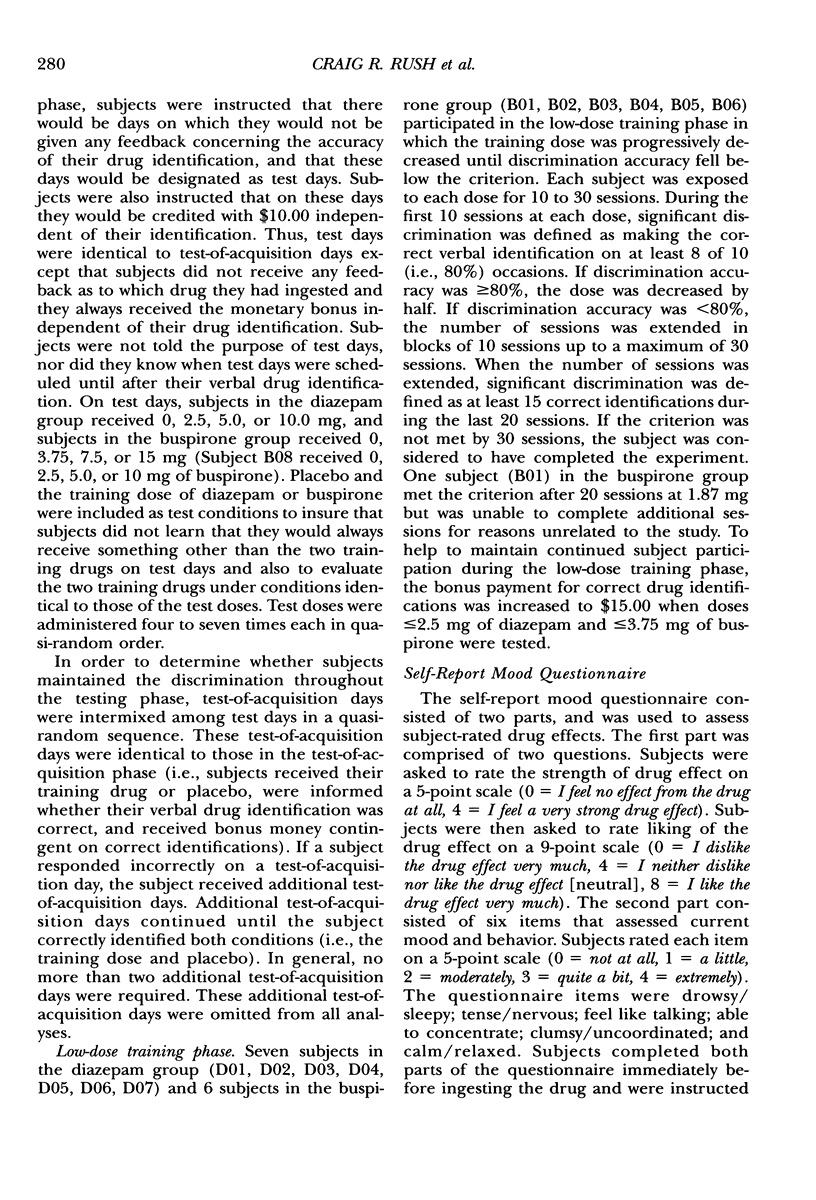
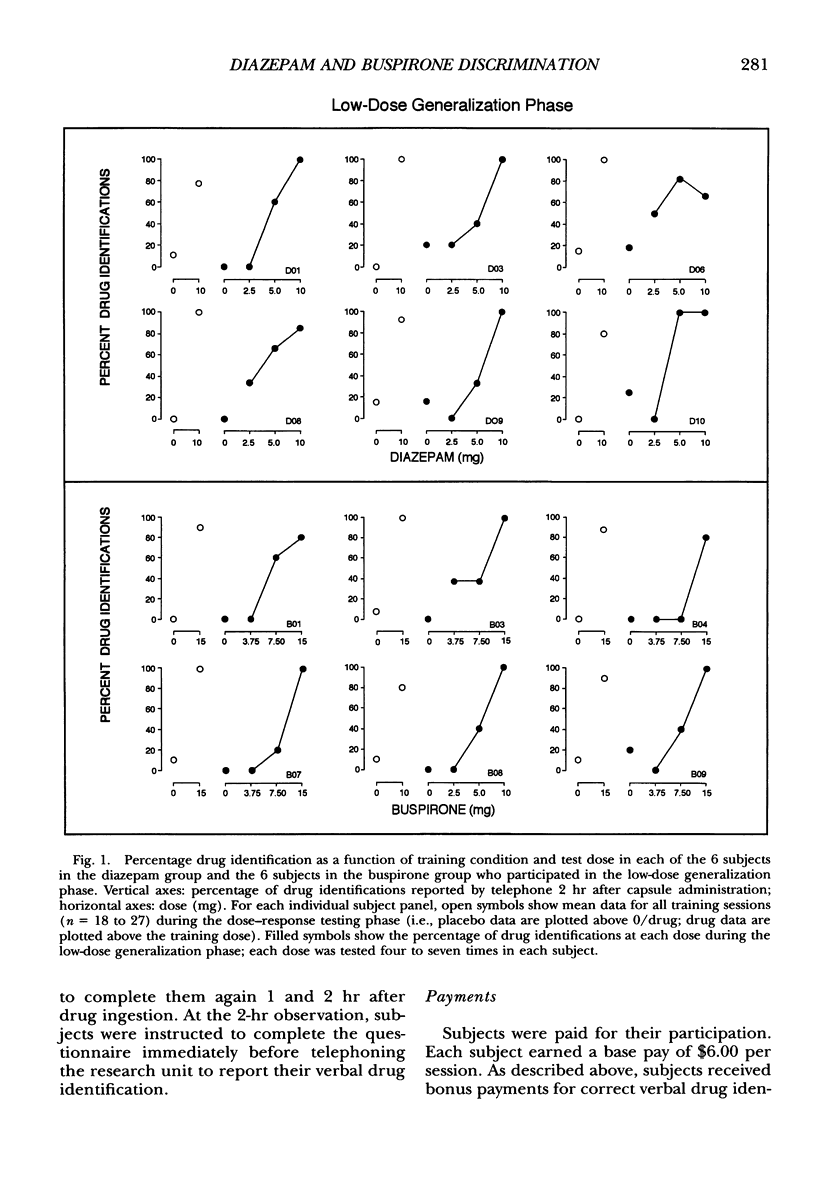
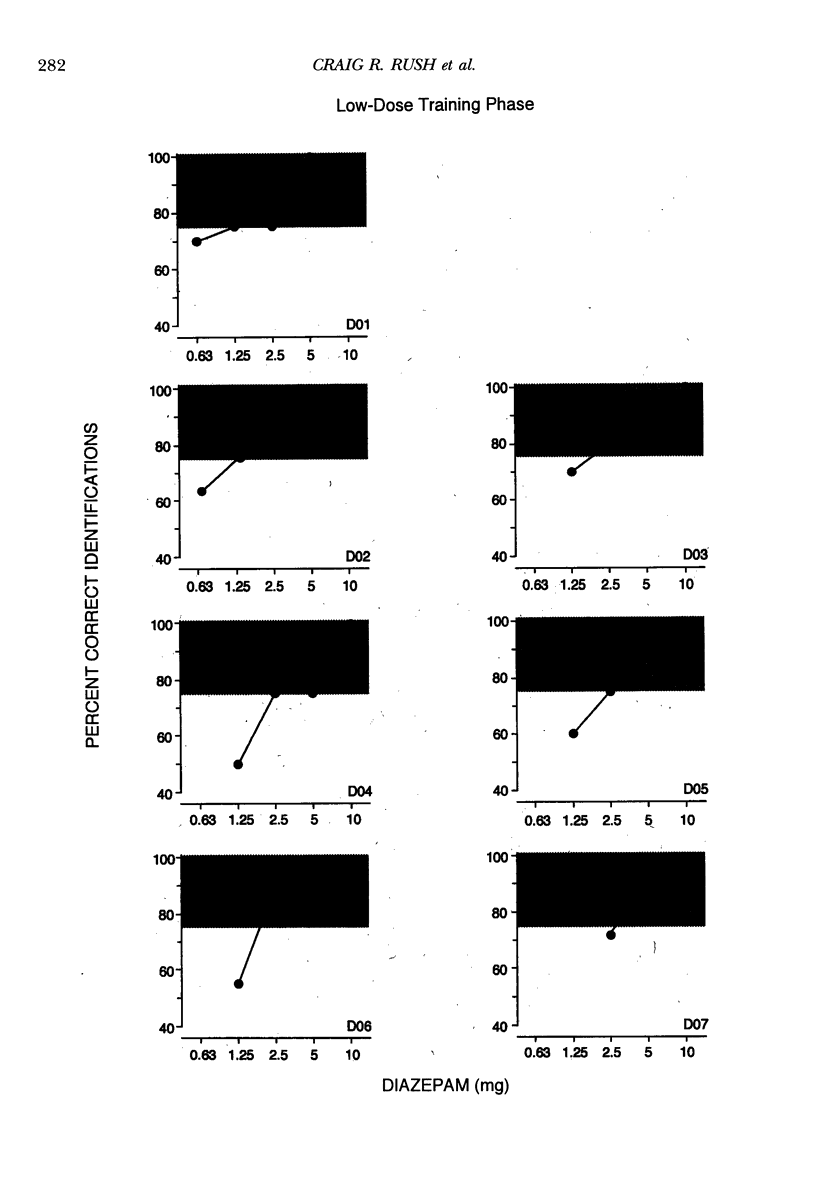

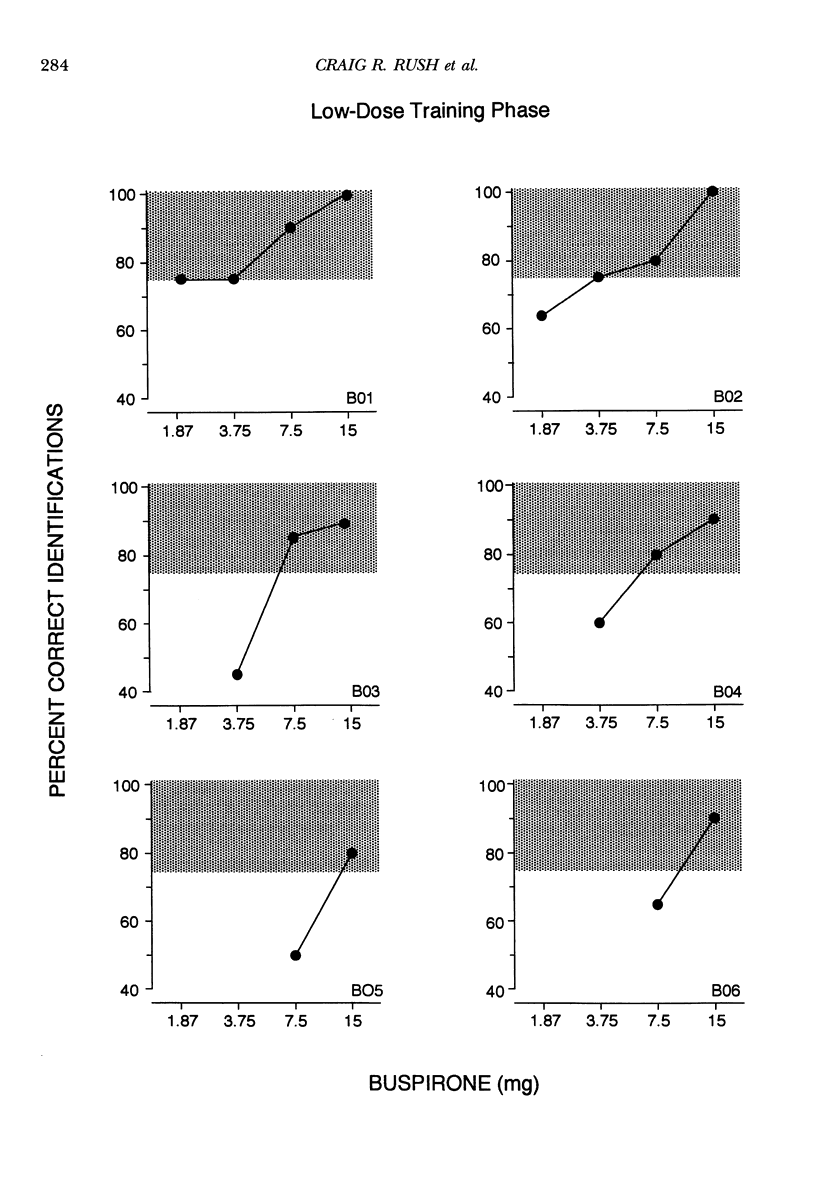
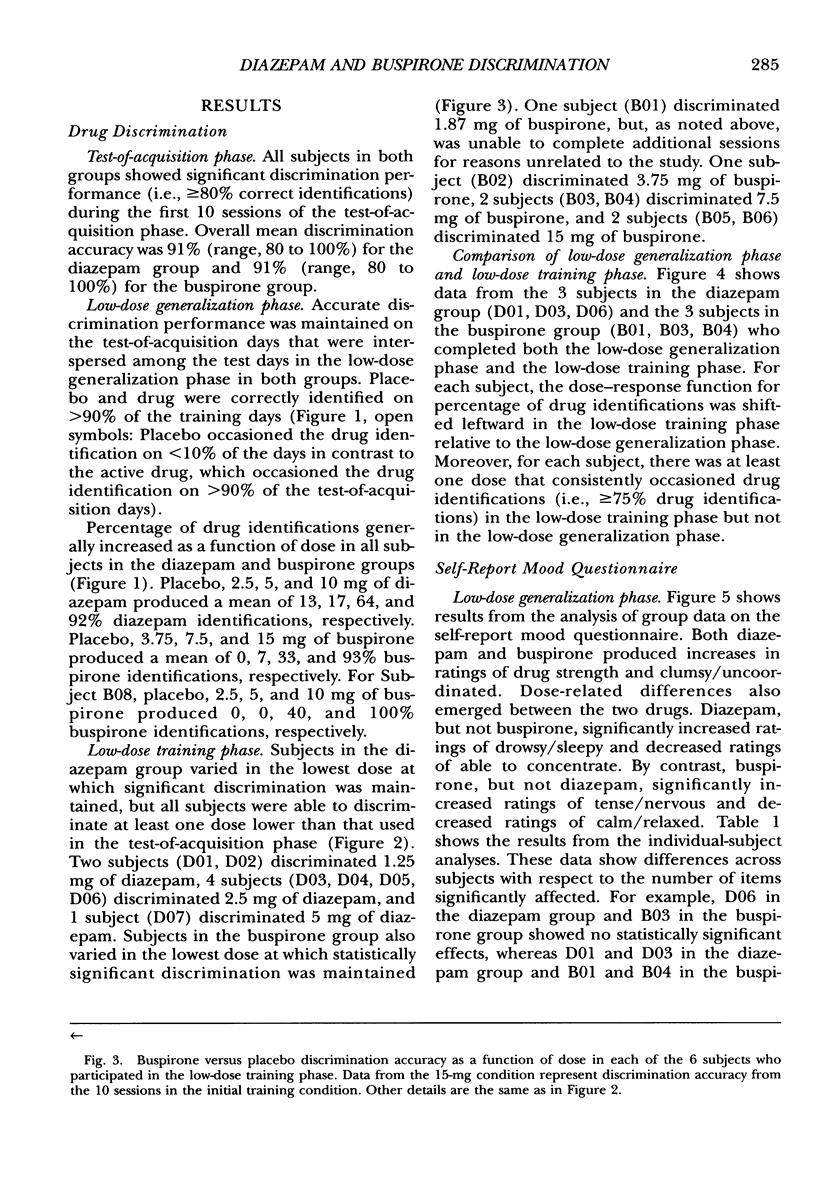
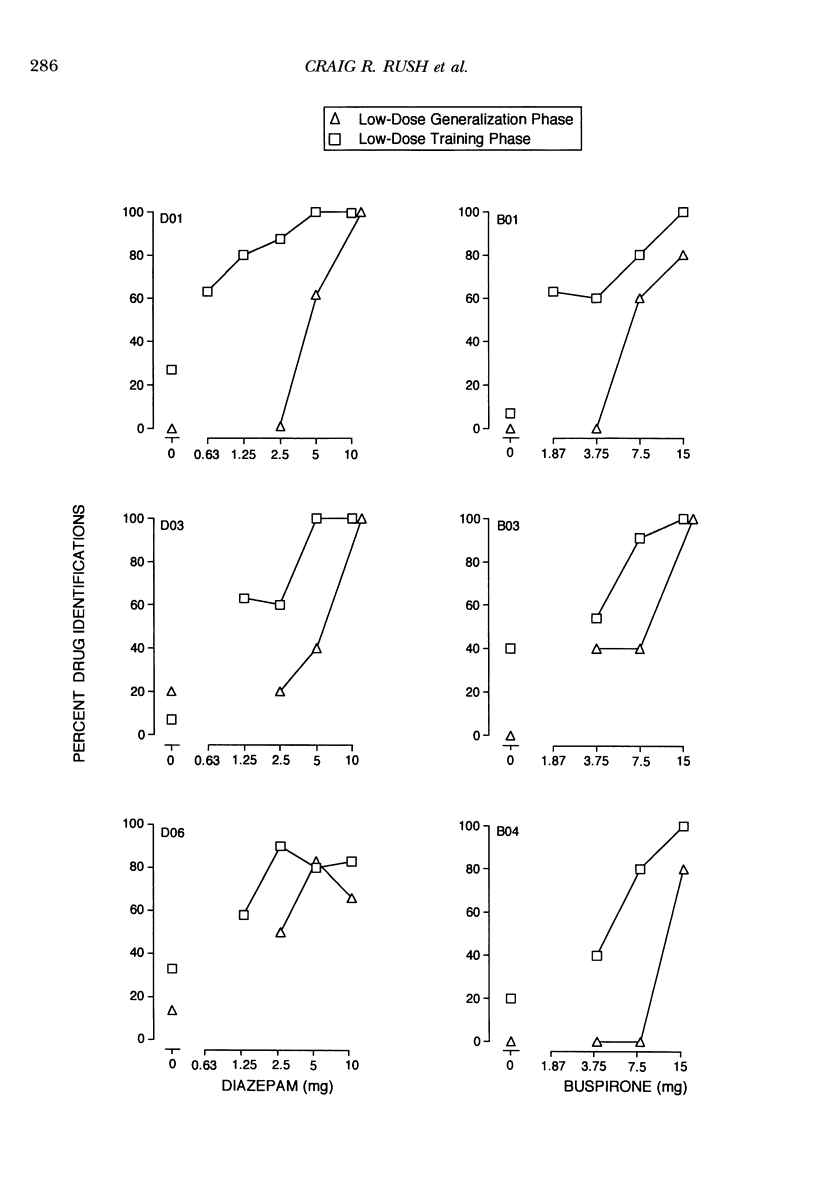
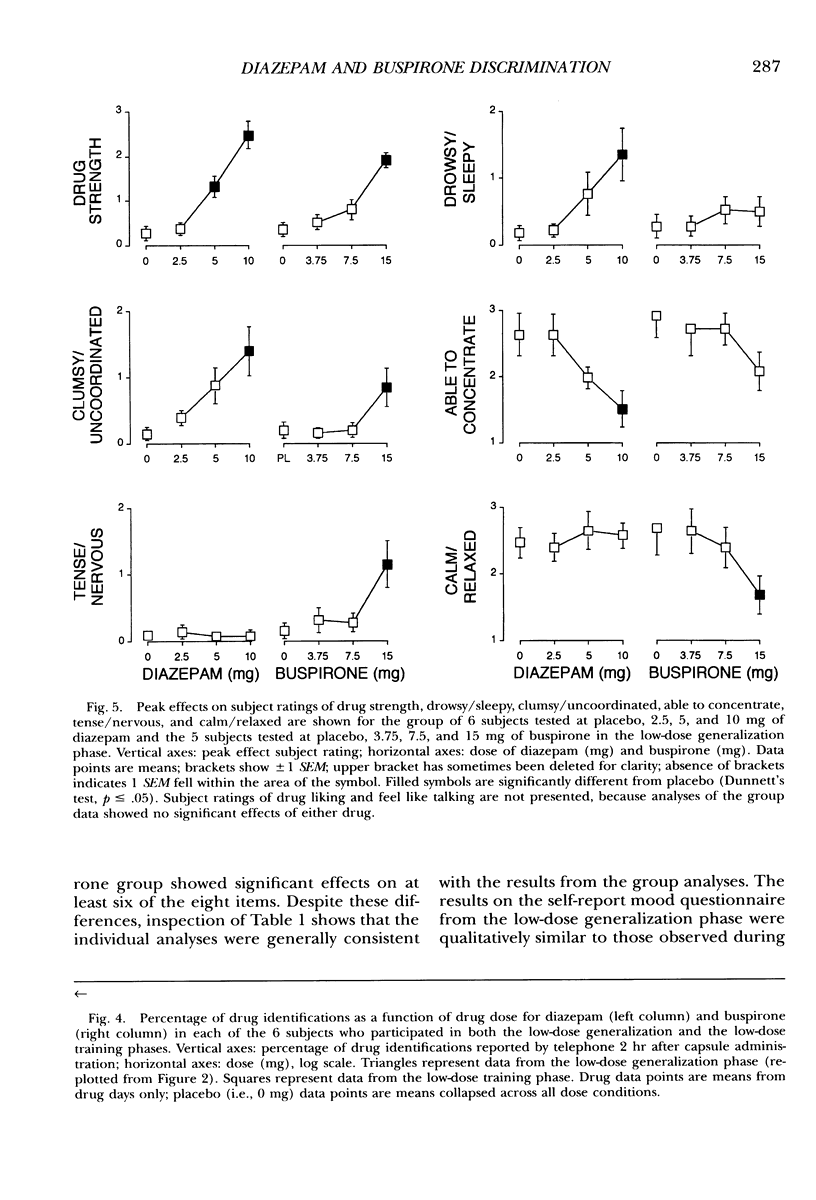
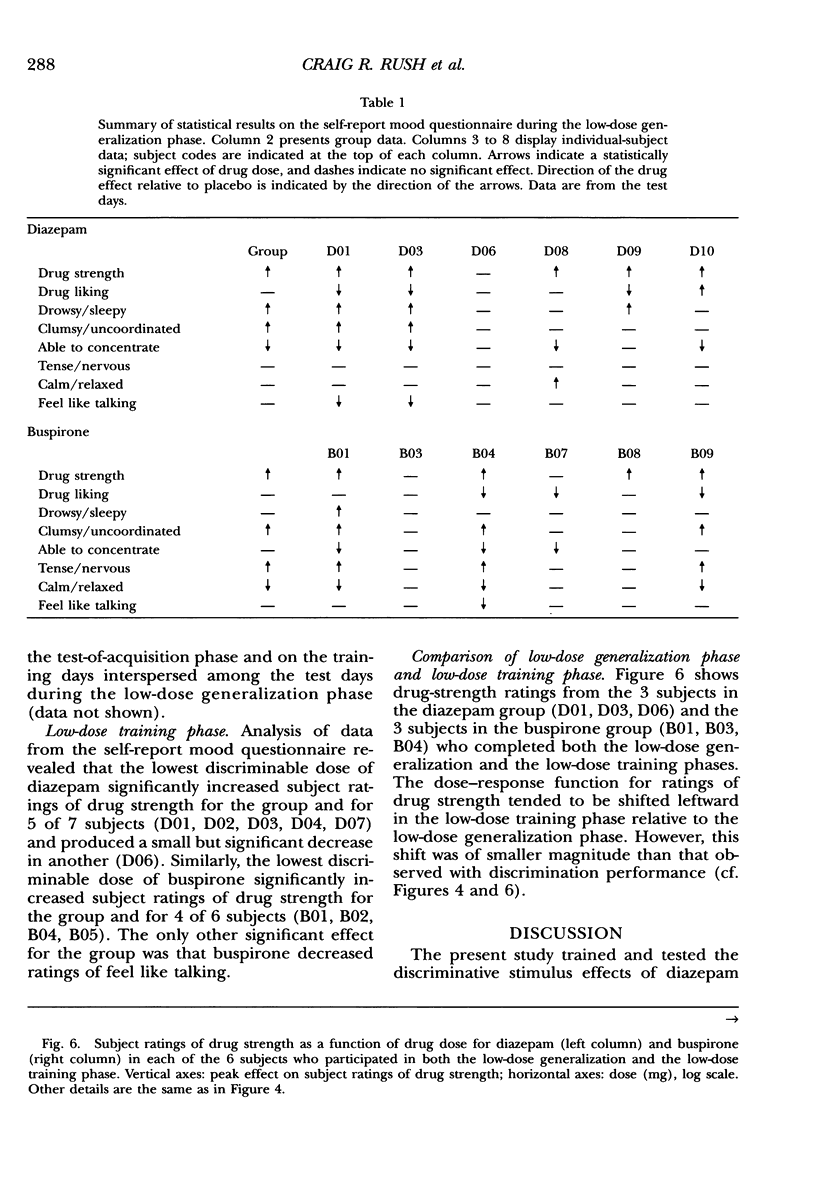
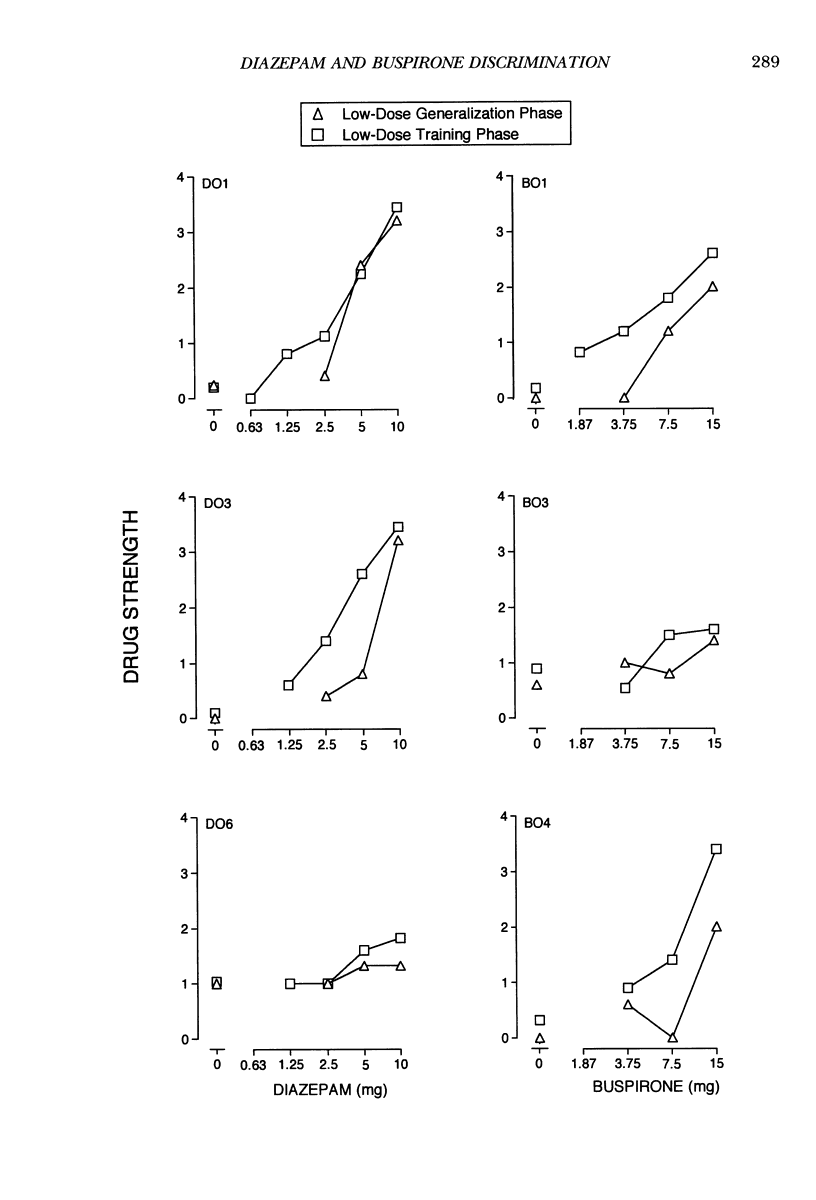
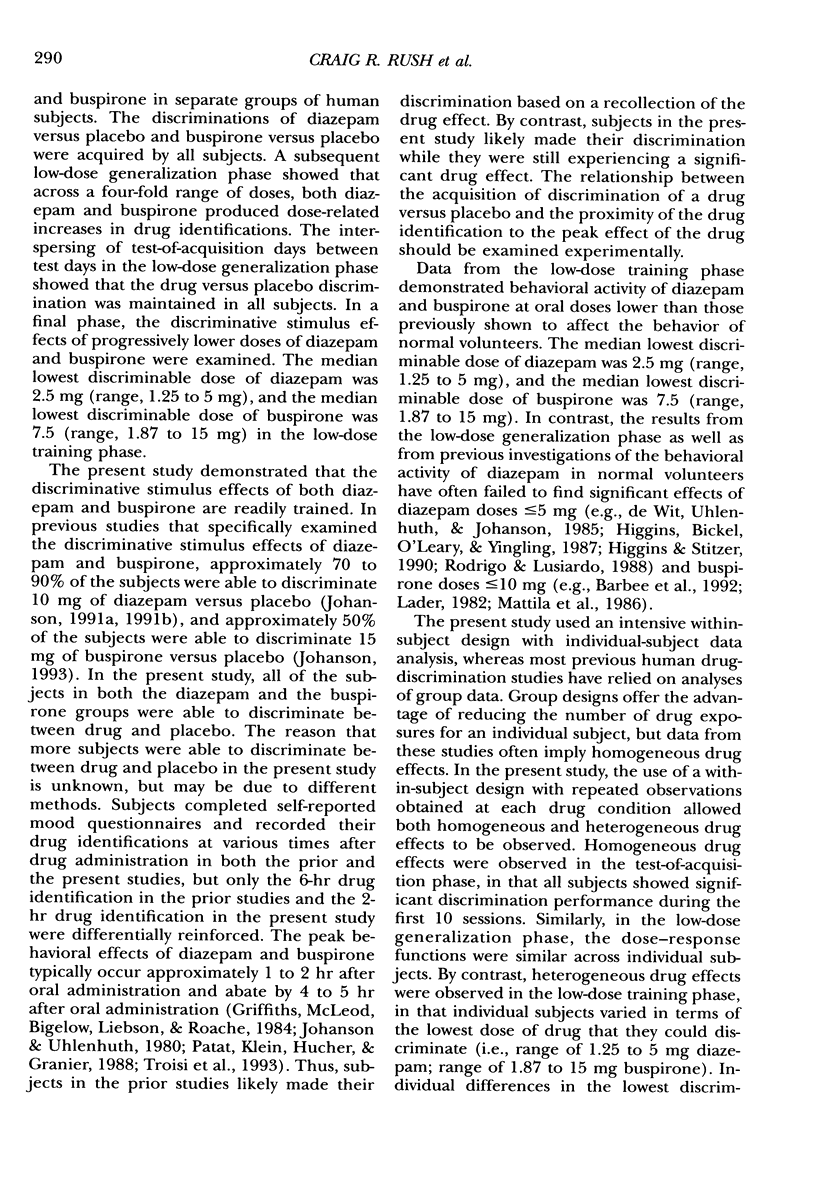
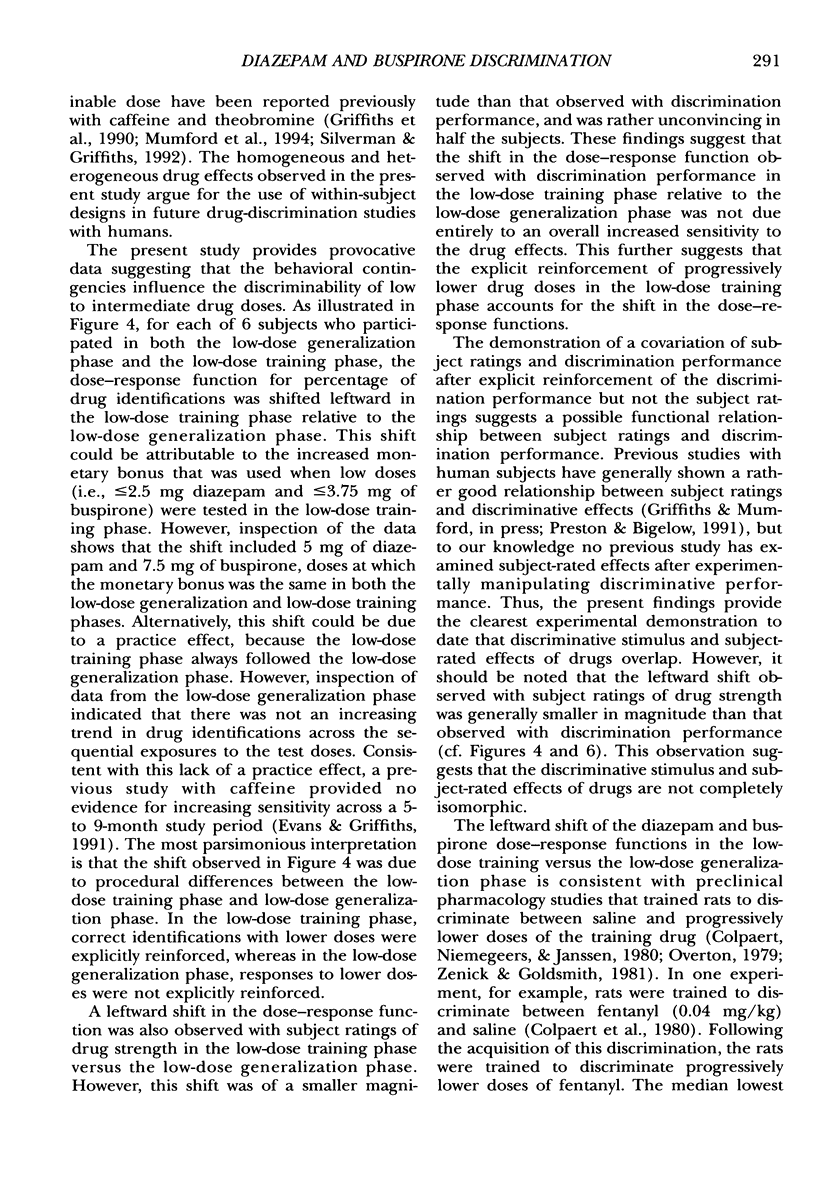
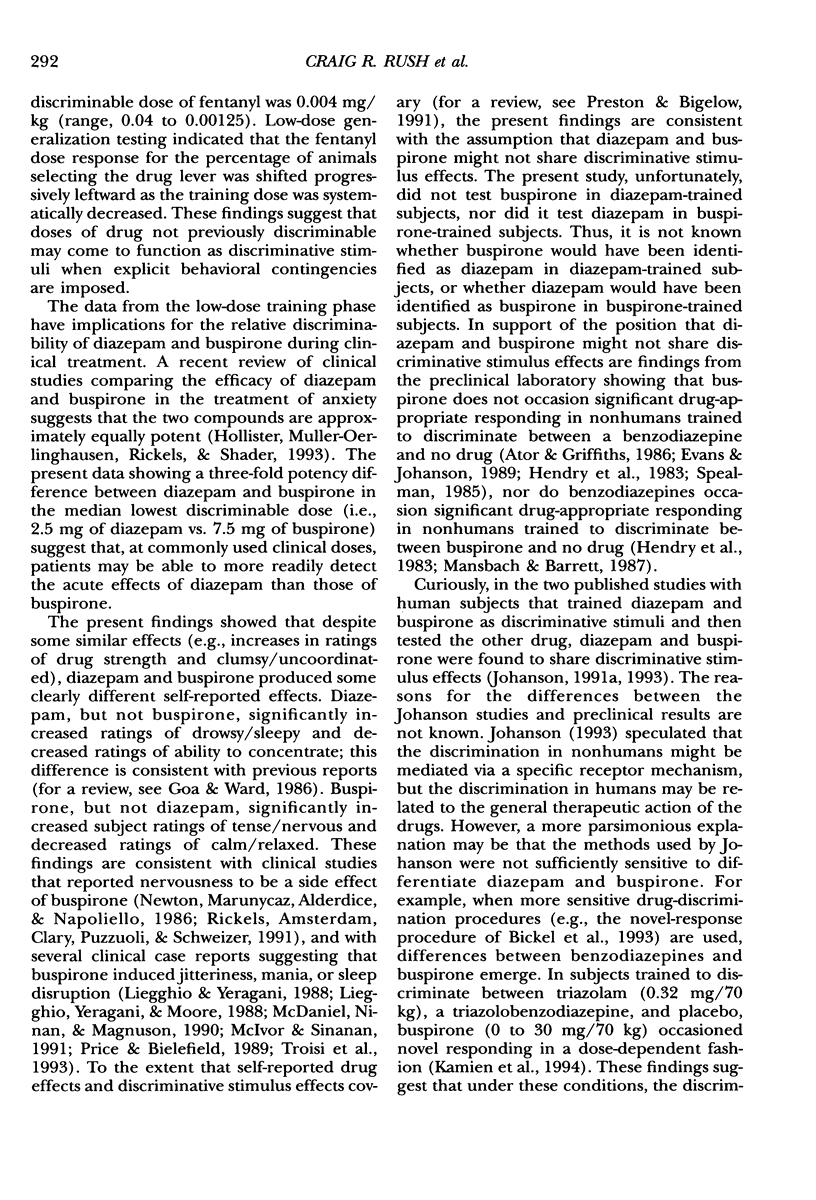
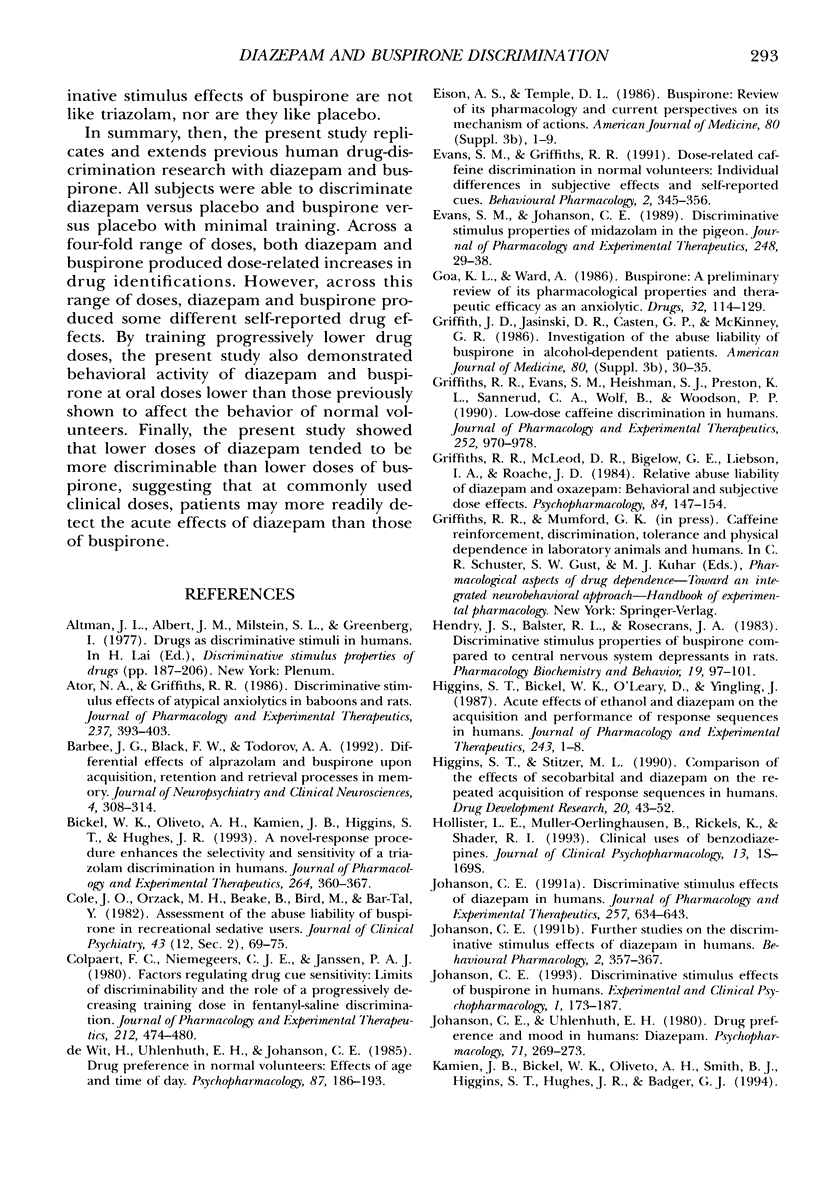
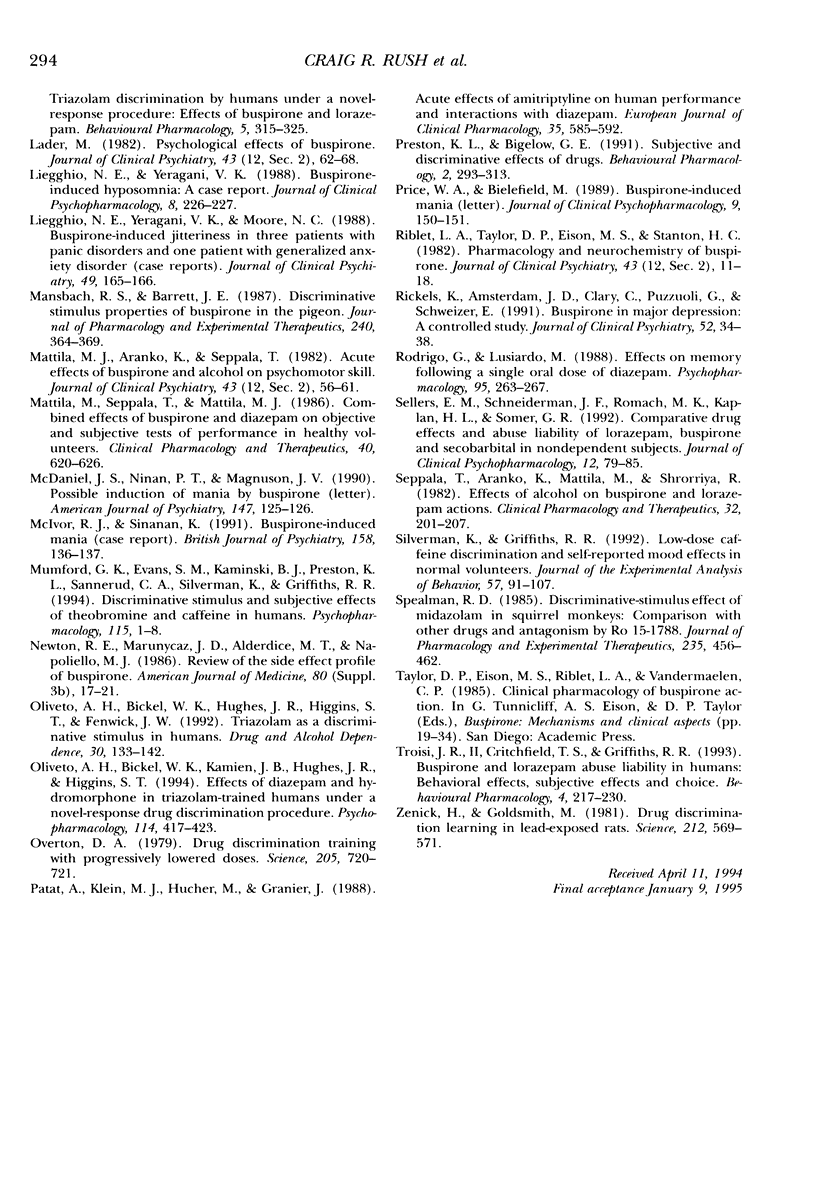
Selected References
These references are in PubMed. This may not be the complete list of references from this article.
- Ator N. A., Griffiths R. R. Discriminative stimulus effects of atypical anxiolytics in baboons and rats. J Pharmacol Exp Ther. 1986 May;237(2):393–403. [PubMed] [Google Scholar]
- Barbee J. G., Black F. W., Todorov A. A. Differential effects of alprazolam and buspirone upon acquisition, retention, and retrieval processes in memory. J Neuropsychiatry Clin Neurosci. 1992 Summer;4(3):308–314. doi: 10.1176/jnp.4.3.308. [DOI] [PubMed] [Google Scholar]
- Bickel W. K., Oliveto A. H., Kamien J. B., Higgins S. T., Hughes J. R. A novel-response procedure enhances the selectivity and sensitivity of a triazolam discrimination in humans. J Pharmacol Exp Ther. 1993 Jan;264(1):360–367. [PubMed] [Google Scholar]
- Cole J. O., Orzack M. H., Beake B., Bird M., Bar-Tal Y. Assessment of the abuse liability of buspirone in recreational sedative users. J Clin Psychiatry. 1982 Dec;43(12 Pt 2):69–75. [PubMed] [Google Scholar]
- Colpaert F. C., Niemegeers C. J., Janssen P. A. Factors regulating drug cue sensitivity: limits of discriminability and the role of a progressively decreasing training dose in fentanyl-saline discrimination. J Pharmacol Exp Ther. 1980 Mar;212(3):474–480. [PubMed] [Google Scholar]
- Eison A. S., Temple D. L., Jr Buspirone: review of its pharmacology and current perspectives on its mechanism of action. Am J Med. 1986 Mar 31;80(3B):1–9. doi: 10.1016/0002-9343(86)90325-6. [DOI] [PubMed] [Google Scholar]
- Evans S. M., Johanson C. E. Discriminative stimulus properties of midazolam in the pigeon. J Pharmacol Exp Ther. 1989 Jan;248(1):29–38. [PubMed] [Google Scholar]
- Evans S.M., Griffiths R.R. Dose-related caffeine discrimination in normal volunteers: individual differences in subjective effects and self-reported cues. Behav Pharmacol. 1991 Nov;2(4-5):345–356. [PubMed] [Google Scholar]
- Goa K. L., Ward A. Buspirone. A preliminary review of its pharmacological properties and therapeutic efficacy as an anxiolytic. Drugs. 1986 Aug;32(2):114–129. doi: 10.2165/00003495-198632020-00002. [DOI] [PubMed] [Google Scholar]
- Griffith J. D., Jasinski D. R., Casten G. P., McKinney G. R. Investigation of the abuse liability of buspirone in alcohol-dependent patients. Am J Med. 1986 Mar 31;80(3B):30–35. doi: 10.1016/0002-9343(86)90329-3. [DOI] [PubMed] [Google Scholar]
- Griffiths R. R., Evans S. M., Heishman S. J., Preston K. L., Sannerud C. A., Wolf B., Woodson P. P. Low-dose caffeine discrimination in humans. J Pharmacol Exp Ther. 1990 Mar;252(3):970–978. [PubMed] [Google Scholar]
- Griffiths R. R., McLeod D. R., Bigelow G. E., Liebson I. A., Roache J. D. Relative abuse liability of diazepam and oxazepam: behavioral and subjective dose effects. Psychopharmacology (Berl) 1984;84(2):147–154. doi: 10.1007/BF00427437. [DOI] [PubMed] [Google Scholar]
- Hendry J. S., Balster R. L., Rosecrans J. A. Discriminative stimulus properties of buspirone compared to central nervous system depressants in rats. Pharmacol Biochem Behav. 1983 Jul;19(1):97–101. doi: 10.1016/0091-3057(83)90317-9. [DOI] [PubMed] [Google Scholar]
- Hollister L. E., Müller-Oerlinghausen B., Rickels K., Shader R. I. Clinical uses of benzodiazepines. J Clin Psychopharmacol. 1993 Dec;13(6 Suppl 1):1S–169S. [PubMed] [Google Scholar]
- Johanson C-E. Further studies on the discriminative stimulus effects of diazepam in humans. Behav Pharmacol. 1991 Nov;2(4-5):357–367. [PubMed] [Google Scholar]
- Johanson C. E. Discriminative stimulus effects of diazepam in humans. J Pharmacol Exp Ther. 1991 May;257(2):634–643. [PubMed] [Google Scholar]
- Johanson C. E., Uhlenhuth E. H. Drug preference and mood in humans: diazepam. Psychopharmacology (Berl) 1980;71(3):269–273. doi: 10.1007/BF00433061. [DOI] [PubMed] [Google Scholar]
- Kamien J.B., Bickel W.K., Oliveto A.H., Smith B.J., Higgins S.T., Hughes J.R., Badger G.J. Triazolam discrimination by humans under a novel response procedure: effects of buspirone and lorazepam. Behav Pharmacol. 1994 Jun;5(3):315–325. doi: 10.1097/00008877-199406000-00009. [DOI] [PubMed] [Google Scholar]
- Lader M. Psychological effects of buspirone. J Clin Psychiatry. 1982 Dec;43(12 Pt 2):62–68. [PubMed] [Google Scholar]
- Liegghio N. E., Yeragani V. K. Buspirone-induced hypomania: a case report. J Clin Psychopharmacol. 1988 Jun;8(3):226–227. doi: 10.1097/00004714-198806000-00022. [DOI] [PubMed] [Google Scholar]
- Liegghio N. E., Yeragani V. K., Moore N. C. Buspirone-induced jitteriness in three patients with panic disorder and one patient with generalized anxiety disorder. J Clin Psychiatry. 1988 Apr;49(4):165–166. [PubMed] [Google Scholar]
- Mansbach R. S., Barrett J. E. Discriminative stimulus properties of buspirone in the pigeon. J Pharmacol Exp Ther. 1987 Feb;240(2):364–369. [PubMed] [Google Scholar]
- Mattila M. J., Aranko K., Seppala T. Acute effects of buspirone and alcohol on psychomotor skills. J Clin Psychiatry. 1982 Dec;43(12 Pt 2):56–61. [PubMed] [Google Scholar]
- Mattila M., Seppälä T., Mattila M. J. Combined effects of buspirone and diazepam on objective and subjective tests of performance in healthy volunteers. Clin Pharmacol Ther. 1986 Dec;40(6):620–626. doi: 10.1038/clpt.1986.236. [DOI] [PubMed] [Google Scholar]
- McDaniel J. S., Ninan P. T., Magnuson J. V. Possible induction of mania by buspirone. Am J Psychiatry. 1990 Jan;147(1):125–126. doi: 10.1176/ajp.147.1.125. [DOI] [PubMed] [Google Scholar]
- McIvor R., Sinanan K. Buspirone-induced mania. Br J Psychiatry. 1991 Jan;158:136–137. doi: 10.1192/bjp.158.1.136. [DOI] [PubMed] [Google Scholar]
- Mumford G. K., Evans S. M., Kaminski B. J., Preston K. L., Sannerud C. A., Silverman K., Griffiths R. R. Discriminative stimulus and subjective effects of theobromine and caffeine in humans. Psychopharmacology (Berl) 1994 Jun;115(1-2):1–8. doi: 10.1007/BF02244744. [DOI] [PubMed] [Google Scholar]
- Newton R. E., Marunycz J. D., Alderdice M. T., Napoliello M. J. Review of the side-effect profile of buspirone. Am J Med. 1986 Mar 31;80(3B):17–21. doi: 10.1016/0002-9343(86)90327-x. [DOI] [PubMed] [Google Scholar]
- Oliveto A. H., Bickel W. K., Hughes J. R., Higgins S. T., Fenwick J. W. Triazolam as a discriminative stimulus in humans. Drug Alcohol Depend. 1992 Jun;30(2):133–142. doi: 10.1016/0376-8716(92)90018-8. [DOI] [PubMed] [Google Scholar]
- Oliveto A. H., Bickel W. K., Kamien J. B., Hughes J. R., Higgins S. T. Effects of diazepam and hydromorphone in triazolam-trained humans under a novel-response drug discrimination procedure. Psychopharmacology (Berl) 1994 Apr;114(3):417–423. doi: 10.1007/BF02249331. [DOI] [PubMed] [Google Scholar]
- Overton D. A. Drug discrimination training with progressively lowered doses. Science. 1979 Aug 17;205(4407):720–721. doi: 10.1126/science.462182. [DOI] [PubMed] [Google Scholar]
- Patat A., Klein M. J., Hucher M., Granier J. Acute effects of amitriptyline on human performance and interactions with diazepam. Eur J Clin Pharmacol. 1988;35(6):585–592. doi: 10.1007/BF00637593. [DOI] [PubMed] [Google Scholar]
- Preston K.L., Bigelow G.E. Subjective and discriminative effects of drugs. Behav Pharmacol. 1991 Nov;2(4-5):293–313. [PubMed] [Google Scholar]
- Price W. A., Bielefeld M. Buspirone-induced mania. J Clin Psychopharmacol. 1989 Apr;9(2):150–151. doi: 10.1097/00004714-198904000-00025. [DOI] [PubMed] [Google Scholar]
- Riblet L. A., Taylor D. P., Eison M. S., Stanton H. C. Pharmacology and neurochemistry of buspirone. J Clin Psychiatry. 1982 Dec;43(12 Pt 2):11–18. [PubMed] [Google Scholar]
- Rickels K., Amsterdam J. D., Clary C., Puzzuoli G., Schweizer E. Buspirone in major depression: a controlled study. J Clin Psychiatry. 1991 Jan;52(1):34–38. [PubMed] [Google Scholar]
- Rodrigo G., Lusiardo M. Effects on memory following a single oral dose of diazepam. Psychopharmacology (Berl) 1988;95(2):263–267. doi: 10.1007/BF00174521. [DOI] [PubMed] [Google Scholar]
- Sellers E. M., Schneiderman J. F., Romach M. K., Kaplan H. L., Somer G. R. Comparative drug effects and abuse liability of lorazepam, buspirone, and secobarbital in nondependent subjects. J Clin Psychopharmacol. 1992 Apr;12(2):79–85. [PubMed] [Google Scholar]
- Seppälä T., Aranko K., Mattila M. J., Shrotriya R. C. Effects of alcohol on buspirone and lorazepam actions. Clin Pharmacol Ther. 1982 Aug;32(2):201–207. doi: 10.1038/clpt.1982.148. [DOI] [PubMed] [Google Scholar]
- Silverman K., Griffiths R. R. Low-dose caffeine discrimination and self-reported mood effects in normal volunteers. J Exp Anal Behav. 1992 Jan;57(1):91–107. doi: 10.1901/jeab.1992.57-91. [DOI] [PMC free article] [PubMed] [Google Scholar]
- Spealman R. D. Discriminative-stimulus effects of midazolam in squirrel monkeys: comparison with other drugs and antagonism by Ro 15-1788. J Pharmacol Exp Ther. 1985 Nov;235(2):456–462. [PubMed] [Google Scholar]
- Troisi 2nd J.R., Critchfield T.S., Griffiths R.R. Buspirone and lorazepam abuse liability in humans: behavioral effects, subjective effects and choice. Behav Pharmacol. 1993 Jun;4(3):217–230. [PubMed] [Google Scholar]
- Zenick H., Goldsmith M. Drug discrimination learning in lead-exposed rats. Science. 1981 May 1;212(4494):569–571. doi: 10.1126/science.7209554. [DOI] [PubMed] [Google Scholar]
- de Wit H., Uhlenhuth E. H., Johanson C. E. Drug preference in normal volunteers: effects of age and time of day. Psychopharmacology (Berl) 1985;87(2):186–193. doi: 10.1007/BF00431805. [DOI] [PubMed] [Google Scholar]


